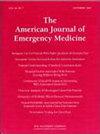Sedation with ketamine, propofol, and dexmedetomidine in pediatric emergency departments
IF 2.7
3区 医学
Q1 EMERGENCY MEDICINE
引用次数: 0
Abstract
Objectives
Describe current practices and variation in procedural sedation with ketamine, propofol and dexmedetomidine in pediatric emergency departments (EDs).
Methods
This was a retrospective study of 40 hospitals in the Pediatric Health Information System from 2016 to 2022, including ED visits for children under 18 years old who received sedation with ketamine, propofol, or dexmedetomidine. We described institutional variation in choice of sedation medication, as well as the differences in both frequency and diagnoses associated with procedural sedation by age.
Results
There were 189,086 ED encounters included in the study. Ketamine was given in 177,502 (94 %) encounters, propofol in 22,916 (12 %), and dexmedetomidine in 3240 (1.7 %). Ketamine was the primary medication used in nearly all institutions, with only a few outliers using propofol or dexmedetomidine. The highest number of sedations occurred in young children (aged 1–7 years), and the number of ED sedation encounters decreased with each year of age beyond 5 years. Notably, infants under 1 year of age were infrequently sedated (1.4 % of all sedations). The most common diagnoses associated with sedation encounters were fractures/dislocations (60 %), followed by lacerations (19 %), and abscesses (5.8 %). Diagnoses varied with age; fractures/dislocations were more common in older age groups, while lacerations and abscesses were disproportionately more common in younger children.
Conclusions
In nearly all institutions, use of ketamine was far more common than use of propofol or dexmedetomidine. The most common diagnoses associated with ED sedation were orthopedic injuries, though diagnoses varied with age. These results illustrate current sedation practices with ketamine, propofol and dexmedetomidine in the pediatric ED and may inform future standardization efforts.
氯胺酮、异丙酚和右美托咪定在儿科急诊科的镇静作用
目的描述目前在儿科急诊科应用氯胺酮、异丙酚和右美托咪定程序性镇静的做法和变化。方法对2016年至2022年儿科健康信息系统中的40家医院进行回顾性研究,包括18岁以下使用氯胺酮、异丙酚或右美托咪定镇静的儿童的急诊科就诊。我们描述了机构在选择镇静药物方面的差异,以及与年龄相关的程序性镇静的频率和诊断的差异。结果共有189086例ED病例纳入研究。氯胺酮177,502例(94%),异丙酚22,916例(12%),右美托咪定3240例(1.7%)。氯胺酮是几乎所有机构使用的主要药物,只有少数例外使用异丙酚或右美托咪定。镇静发生在幼儿(1-7岁)中最多,5岁以上的ED镇静次数逐年减少。值得注意的是,1岁以下的婴儿很少使用镇静剂(占所有镇静剂的1.4%)。与镇静治疗相关的最常见诊断是骨折/脱位(60%),其次是撕裂伤(19%)和脓肿(5.8%)。诊断因年龄而异;骨折/脱位在年龄较大的人群中更为常见,而撕裂和脓肿在年龄较小的儿童中更为常见。结论在几乎所有的医疗机构中,氯胺酮的使用远远多于异丙酚和右美托咪定。与ED镇静相关的最常见诊断是骨科损伤,尽管诊断因年龄而异。这些结果说明了目前氯胺酮、异丙酚和右美托咪定在儿科急诊科的镇静实践,并可能为未来的标准化工作提供信息。
本文章由计算机程序翻译,如有差异,请以英文原文为准。
求助全文
约1分钟内获得全文
求助全文
来源期刊
CiteScore
6.00
自引率
5.60%
发文量
730
审稿时长
42 days
期刊介绍:
A distinctive blend of practicality and scholarliness makes the American Journal of Emergency Medicine a key source for information on emergency medical care. Covering all activities concerned with emergency medicine, it is the journal to turn to for information to help increase the ability to understand, recognize and treat emergency conditions. Issues contain clinical articles, case reports, review articles, editorials, international notes, book reviews and more.

 求助内容:
求助内容: 应助结果提醒方式:
应助结果提醒方式:


